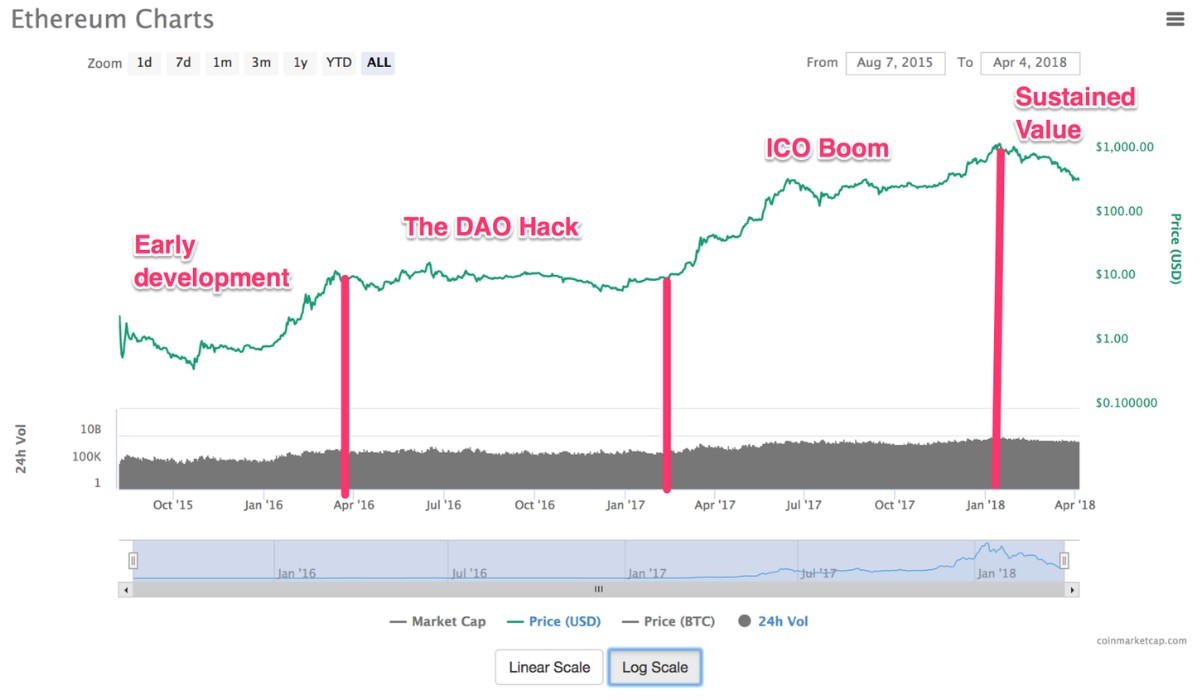Introduction
Welcome to the world of cryptocurrencies! Over the past decade, digital currencies have emerged as a groundbreaking innovation that has revolutionized the way we perceive and transact value. Among the many cryptocurrencies available in the market, Ethereum has gained significant attention and popularity. Not only does it serve as a decentralized platform for various applications, but it also allows users to create their own cryptocurrencies on top of its blockchain.
Creating a cryptocurrency on Ethereum can be an exciting and rewarding endeavor. It provides individuals and businesses with the opportunity to tokenize assets, build decentralized applications, or even launch their own digital currencies. In this article, we will walk you through the process of creating a cryptocurrency on Ethereum, from setting up an Ethereum wallet to deploying and managing your own token.
Before we dive into the technicalities of the process, it’s crucial to have a basic understanding of Ethereum and cryptocurrencies in general. Ethereum is a blockchain-based platform that enables developers to build decentralized applications (dApps) and execute smart contracts. It utilizes a native cryptocurrency called Ether (ETH) to facilitate transactions and incentivize participants in the network.
Now, what exactly is a cryptocurrency? In simple terms, a cryptocurrency is a digital or virtual currency that relies on cryptography for security. Unlike traditional currencies issued by governments, cryptocurrencies operate on decentralized networks, such as blockchains, and are not subject to centralized control or regulation. They use cryptographic techniques to secure and verify transactions and maintain the integrity of the network.
Creating a cryptocurrency on Ethereum offers several benefits compared to building one from scratch or using other platforms. Firstly, Ethereum provides a robust and mature ecosystem with a large and active developer community. This means that you can leverage existing tools, libraries, and frameworks to simplify your development process. Additionally, Ethereum supports smart contracts, which are self-executing contracts with predefined rules and conditions encoded on the blockchain. Smart contracts can automate various processes, such as token issuance, transfers, and interactions with other contracts, making it easier to manage and scale your cryptocurrency.
In the following sections, we will guide you through the step-by-step process of creating your own cryptocurrency on Ethereum. From setting up an Ethereum wallet to distributing and managing tokens, you will gain a comprehensive understanding of how to navigate the world of decentralized finance. So, without further ado, let’s get started!
Understanding Ethereum
Before we delve into the process of creating a cryptocurrency on Ethereum, it is essential to have a solid understanding of the platform itself. Ethereum is a decentralized, open-source blockchain network that allows developers to build and deploy smart contracts and decentralized applications (dApps).
At its core, Ethereum operates as a global, shared infrastructure that facilitates the creation and execution of smart contracts. Smart contracts are self-executing agreements that automatically enforce the terms and conditions defined within their code. They eliminate the need for intermediaries or trusted third parties, making transactions more efficient, transparent, and secure.
Ethereum’s blockchain consists of a network of computers, or nodes, that work together to maintain a decentralized ledger of all transactions and smart contracts. This distributed nature ensures that no single entity has control over the network, enhancing its security and resilience. Transactions and contract interactions on the Ethereum blockchain are validated through a consensus mechanism called Proof of Stake (PoS) or Proof of Work (PoW), depending on the version.
Ether (ETH) is the native cryptocurrency of the Ethereum network. It serves as a means of value transfer and is used to pay for transaction fees and computational services within the network. Users can acquire ETH through exchanges or participate in Ethereum’s consensus mechanism by validating transactions and contributing to network security.
One of the key features that sets Ethereum apart from other blockchains is its support for smart contracts. Smart contracts on Ethereum are written in a programming language called Solidity. These contracts can define rules, conditions, and actions that are automatically executed when certain conditions are met. Smart contracts open up a wide range of possibilities, from creating custom tokens and managing decentralized organizations to implementing complex financial instruments and conducting Initial Coin Offerings (ICOs).
Ethereum’s adaptability and programmability make it a versatile platform for building decentralized applications. dApps are applications that run on a blockchain, utilizing the decentralized nature of the network to provide transparency, immutability, and enhanced security. These applications can range from decentralized finance (DeFi) protocols and prediction markets to decentralized social media platforms and supply chain management systems.
As Ethereum continues to evolve, it is transitioning from its original Proof of Work (PoW) consensus mechanism to a more energy-efficient Proof of Stake (PoS) mechanism known as Ethereum 2.0. This upgrade aims to increase the network’s scalability, security, and sustainability, paving the way for the widespread adoption of decentralized applications and cryptocurrencies.
Now that we have laid the groundwork and explored the fundamental aspects of Ethereum, we can proceed to the next step: creating a cryptocurrency on this innovative blockchain platform. By harnessing the power of Ethereum’s smart contracts, we can bring our digital currency to life and unlock a world of possibilities in the decentralized finance landscape.
What is a Cryptocurrency?
A cryptocurrency is a digital or virtual form of currency that utilizes cryptography for secure financial transactions, control the creation of new units, and verify the transfer of assets. Unlike traditional fiat currencies issued by central banks, cryptocurrencies operate on decentralized networks, such as blockchains, which allow for peer-to-peer transactions without the need for intermediaries.
One of the key characteristics of cryptocurrencies is their cryptographic nature. Cryptography involves the use of cryptographic algorithms to secure and verify transactions and control the creation of new units. This ensures the integrity and security of the cryptocurrency network, making it resistant to counterfeiting and tampering.
The most well-known cryptocurrency is Bitcoin, which was introduced in 2009 by an anonymous individual or group of individuals known as Satoshi Nakamoto. Bitcoin served as the pioneering decentralized digital currency, utilizing blockchain technology to record and validate transactions without the need for a centralized authority.
Since the inception of Bitcoin, numerous other cryptocurrencies have been developed, each with its unique features, use cases, and underlying technology. Ethereum is one of the most notable cryptocurrencies, known not only for its native cryptocurrency Ether (ETH) but also for its ability to support the creation of decentralized applications and smart contracts.
Cryptocurrencies are typically created using a process called mining or through the initial distribution of digital tokens through a process known as an initial coin offering (ICO). Miners use powerful computers to solve complex mathematical problems, contributing computational power to secure the network and validate transactions. In return, they are rewarded with newly minted cryptocurrency units.
One of the primary advantages of cryptocurrencies is their potential for financial inclusion and empowerment. Traditional banking systems can have limitations, such as high fees, account restrictions, and lengthy transaction times. Cryptocurrencies, on the other hand, offer an alternative that can be accessed by anyone with an internet connection, providing financial services to unbanked or underbanked populations worldwide.
Cryptocurrencies also provide greater transparency through their public blockchain networks. Every transaction is recorded and visible on the blockchain, making it difficult to manipulate or alter transaction histories. This transparency reduces the risks of fraud and enhances trust among participants.
Furthermore, cryptocurrencies have the potential to revolutionize various industries by enabling secure and efficient peer-to-peer transactions and introducing new financial instruments, such as decentralized lending, decentralized exchanges, and tokenized assets.
While cryptocurrencies offer exciting opportunities, it is important to note that they also come with risks. Cryptocurrency markets can be highly volatile, and the value of a cryptocurrency can fluctuate dramatically within short periods. It is crucial for individuals to be knowledgeable and exercise caution when investing or using cryptocurrencies.
In summary, cryptocurrencies are digital or virtual currencies that utilize cryptography for secure transactions and operate on decentralized networks. They offer the potential for financial inclusion, transparency, and innovation, but also come with risks. By understanding the fundamentals of cryptocurrencies, we can embark on the journey of creating our own cryptocurrency on the Ethereum platform and explore the possibilities of decentralized finance.
Benefits of Creating a Cryptocurrency on Ethereum
Creating a cryptocurrency on the Ethereum platform offers numerous benefits and advantages for individuals and businesses alike. Here are some of the key advantages of utilizing Ethereum for building your own digital currency:
1. Established Ecosystem: Ethereum has a robust and well-established ecosystem, supported by a large and active community of developers, entrepreneurs, and enthusiasts. This means that you can leverage existing tools, libraries, and frameworks to simplify the development process and accelerate your project.
2. Smart Contract Functionality: Ethereum’s support for smart contracts is a game-changer when it comes to creating cryptocurrencies. Smart contracts are self-executing contracts with predefined rules and conditions encoded on the blockchain. They can automate various processes, such as token issuance, transfers, and interactions with other contracts. This enables you to build sophisticated features and functionalities for your cryptocurrency without having to rely on external systems or intermediaries.
3. Interoperability: Ethereum provides interoperability with other smart contracts and decentralized applications (dApps) within its ecosystem. This means that your cryptocurrency can seamlessly integrate with existing Ethereum-based applications, enabling users to easily interact with your token and access various services and functionalities.
4. Standardization and Token Standards: Ethereum has introduced several token standards that have become industry standards in the cryptocurrency space. The most well-known is the ERC-20 (Ethereum Request for Comments 20) token standard, which defines a set of rules and guidelines for creating fungible tokens on the Ethereum network. By adhering to these standards, your cryptocurrency can easily integrate with wallets, exchanges, and other applications that support ERC-20 tokens.
5. Decentralization and Security: Ethereum operates on a decentralized blockchain network, which means that the control and operation of your cryptocurrency are distributed among multiple nodes. This enhances the security of the network, making it highly resistant to censorship, fraud, and attacks. Additionally, Ethereum’s consensus mechanism ensures the integrity and immutability of the blockchain, providing a trusted environment for your cryptocurrency.
6. Global Reach and Accessibility: Ethereum is a global platform that offers accessibility to users from all around the world. By creating your cryptocurrency on Ethereum, you can reach a global audience and tap into a vast ecosystem of users, investors, and potential partners. This opens up opportunities for adoption, liquidity, and growth.
7. Innovation and Future-Proofing: Ethereum is continuously evolving and innovating through upgrades and research initiatives. The upcoming transition to Ethereum 2.0, which will introduce significant scalability improvements, is a testament to the platform’s commitment to staying at the forefront of blockchain technology. By building your cryptocurrency on Ethereum, you can future-proof your project and benefit from ongoing advancements in the ecosystem.
These are just a few of the benefits that come with creating a cryptocurrency on the Ethereum platform. By leveraging Ethereum’s established ecosystem, smart contract functionality, interoperability, and security, you can bring your digital currency to life and unlock a world of possibilities in the decentralized finance space.
Step 1: Set Up an Ethereum Wallet
Before you can create a cryptocurrency on the Ethereum platform, you need to have an Ethereum wallet to store, send, and receive your digital assets. An Ethereum wallet is a software application that allows you to interact with the Ethereum blockchain and manage your cryptocurrency holdings. Here are the steps to set up an Ethereum wallet:
1. Choose a Wallet: There are several types of Ethereum wallets available, including desktop wallets, mobile wallets, hardware wallets, and web-based wallets. Each option has its own advantages and considerations. Desktop wallets, such as MetaMask or MyEtherWallet, are software applications that you install on your computer. Mobile wallets, like Trust Wallet or Coinbase Wallet, are apps that you can download on your smartphone. Hardware wallets, such as Ledger or Trezor, are physical devices that store your private keys offline. Web-based wallets, such as MyCrypto or Exodus, are accessible through a web browser. Choose the wallet that suits your needs and install it on your preferred device.
2. Create a New Wallet: Once you have chosen a wallet, follow the instructions to create a new Ethereum wallet. This usually involves generating a strong password and securely storing your recovery phrase or seed phrase. The recovery phrase is crucial for restoring access to your wallet in case you forget your password or lose access to your device.
3. Secure your Wallet: Implementing robust security measures is essential to protect your cryptocurrency holdings. Enable any additional security features offered by your wallet, such as two-factor authentication (2FA) or biometric authentication. Ensure that your device has the latest security updates, use a reliable antivirus/malware protection software, and be cautious of phishing attempts.
4. Back Up your Wallet: It is crucial to regularly back up your Ethereum wallet to ensure you can restore access to your funds if your device is lost, stolen, or damaged. Most wallets provide an option to export or save your wallet’s private keys or recovery phrase. Store this backup in a secure offline location, preferably in multiple physical locations to mitigate the risk of losing access to your funds.
5. Fund your Wallet: Once your wallet is set up and secured, you need to fund it with Ether (ETH) to cover transaction fees and interact with the Ethereum network. You can acquire ETH by purchasing it from cryptocurrency exchanges, receiving it from others, or participating in token sales or airdrops. Use your wallet’s address to receive ETH from external sources.
6. Test your Wallet: It is essential to test your wallet by sending a small amount of ETH to another Ethereum address to ensure that your wallet is functioning correctly and you have a good understanding of the transaction process. This will help you become familiar with the wallet’s interface and gain confidence in managing your cryptocurrency.
7. Keep Learning: Ethereum wallets and the cryptocurrency landscape, in general, are continually evolving. Stay updated on new wallet features, security best practices, and industry developments. Keep learning about the different wallet options and explore additional functionalities provided by your chosen wallet, such as decentralized finance (DeFi) integrations or token swapping.
By following these steps and setting up an Ethereum wallet, you lay the foundation for creating and managing your own cryptocurrency on the Ethereum platform. Once your wallet is ready, you can proceed to the next steps, which involve installing the necessary development tools and writing the smart contract code for your cryptocurrency.
Step 2: Install and Set Up the Ethereum Development Tools
After setting up an Ethereum wallet, the next step in creating a cryptocurrency on Ethereum is to install and set up the necessary Ethereum development tools. These tools will provide you with the environment and resources needed to write, compile, and deploy smart contracts on the Ethereum network. Here’s how you can install and set up the Ethereum development tools:
1. Install Node.js: Node.js is a JavaScript runtime environment that allows you to run JavaScript code outside of a browser. It is required to install and run various Ethereum development tools. Visit the official Node.js website and download the appropriate installer for your operating system. Follow the installation instructions provided by the installer. Once installed, you can verify that Node.js is properly installed by opening a command prompt or terminal and running the command node -v.
2. Install an Integrated Development Environment (IDE): While not strictly necessary, using an IDE can greatly enhance your coding experience. Some popular options for Ethereum development include Visual Studio Code, Remix, and Truffle. Choose the IDE that suits your preferences and install it on your machine. IDEs offer features like code highlighting, autocomplete, debugging, and seamless integration with Ethereum development tools.
3. Set Up a Project Directory: Create a dedicated directory on your computer to store all the files related to your cryptocurrency project. This directory will serve as a workspace for your code and assets. Open your IDE and navigate to the project directory.
4. Initialize an Ethereum Project: To streamline the development process, you can use frameworks like Truffle or Hardhat that provide a set of preconfigured tools and utilities for Ethereum development. In your project directory, open a command prompt or terminal and run the command to initialize a new Ethereum project using your chosen framework. For example, to use Truffle, run the command truffle init. This will create a basic project structure with configuration files and directories.
5. Configure the Project: Open the configuration file provided by your framework (e.g., truffle-config.js for Truffle) and configure the necessary settings, such as the network provider (e.g., local development network, testnet, or mainnet) and the compiler version. Configure any additional settings or plugins specific to your project requirements.
6. Connect to an Ethereum Network: To interact with the Ethereum network, you need to connect to a network provider. For local development and testing, you can use tools like Ganache or Hardhat Network to set up a local Ethereum network. Alternatively, you can connect to public testnets, such as Ropsten or Kovan, for more realistic testing scenarios. Configure your project to connect to the desired network by specifying the network settings in your framework’s configuration file.
7. Install Additional Dependencies: Depending on your project requirements, you may need to install additional dependencies or libraries. This could include Ethereum libraries, smart contract development libraries, or utility libraries. Use your framework’s package manager (e.g., npm for Truffle) to install the required packages and dependencies. Make sure to specify the correct versions of the packages to ensure compatibility.
8. Verify the Setup: To ensure everything is set up correctly, run some basic commands or scripts provided by your chosen framework. For example, you can compile the sample smart contract provided by the framework or run a sample test script. Verify that the commands execute successfully and that there are no errors or issues reported.
After completing these steps, you will have an Ethereum development environment set up and ready to start writing the smart contract code for your cryptocurrency. The development tools and framework you have installed will provide you with the necessary features and utilities to streamline the development process and test your smart contracts locally or on the Ethereum network.
Step 3: Write the Smart Contract Code
Writing the smart contract code is a crucial step in creating your cryptocurrency on the Ethereum platform. Smart contracts are self-executing contracts with predefined rules and conditions encoded on the blockchain. These contracts control the behavior and functionality of your cryptocurrency, determining factors such as token supply, transfers, and interactions with other contracts. Follow these steps to write the smart contract code for your cryptocurrency:
1. Open your IDE: Launch your integrated development environment (IDE), such as Visual Studio Code or Remix, and open the project directory where you have set up your Ethereum project.
2. Create a New Solidity Contract: Solidity is the programming language used to write smart contracts on the Ethereum platform. In your project directory, create a new Solidity file with a `.sol` extension. This file will contain the code for your cryptocurrency’s smart contract.
3. Define the Contract: Start by defining the contract and giving it a meaningful name. For example, `MyToken` or `MyCoin`. Declare the contract using the `contract` keyword followed by the contract name. For example:
solidity
contract MyToken {
// Contract code goes here
}
4. Define the Contract Variables: In your smart contract, you need to define variables to track the state of your cryptocurrency. These variables may include the total supply of tokens, the balances of individual accounts, and any additional data you wish to store. Define these variables inside the contract scope. For example:
solidity
contract MyToken {
string public name;
string public symbol;
uint256 public totalSupply;
// Additional variables go here
}
5. Implement Constructor and Initialization: If desired, you can include a constructor function in your smart contract to initialize the initial state of your cryptocurrency. This function is executed once during contract creation. Define the constructor function using the `constructor` keyword, and initialize the contract variables within it. For example:
solidity
contract MyToken {
string public name;
string public symbol;
uint256 public totalSupply;
constructor() {
name = “My Token”;
symbol = “MT”;
totalSupply = 1000000;
// Initialize other variables here
}
// Additional contract functions go here
}
6. Implement Contract Functions: Define additional functions within your smart contract to enable various operations, such as transferring tokens, querying balances, and managing token supply. These functions should be carefully designed to ensure the security and integrity of your cryptocurrency. Consider using access modifiers, such as `public`, `private`, or `internal`, to control the visibility and accessibility of functions. Implement the desired behaviors and logic for each function. For example:
solidity
contract MyToken {
string public name;
string public symbol;
uint256 public totalSupply;
mapping(address => uint256) public balances;
constructor() {
name = “My Token”;
symbol = “MT”;
totalSupply = 1000000;
balances[msg.sender] = totalSupply;
}
function transfer(address recipient, uint256 amount) public {
require(amount <= balances[msg.sender], "Insufficient balance");
balances[msg.sender] -= amount;
balances[recipient] += amount;
}
function balanceOf(address account) public view returns (uint256) {
return balances[account];
}
// Additional contract functions go here
}
7. Compile the Smart Contract: Use your chosen Ethereum development framework, such as Truffle, to compile the smart contract code. This will ensure that the code is error-free and ready for deployment onto the Ethereum network.
8. Test the Smart Contract: It is vital to thoroughly test your smart contract code to ensure its reliability and correctness. Write test scripts using frameworks like Truffle or Hardhat that simulate different scenarios and interactions with your smart contract. Execute the test scripts and verify that the contract behaves as expected and handles edge cases properly.
By following these steps and writing the smart contract code, you define the rules and logic for your cryptocurrency on the Ethereum network. The smart contract code determines the functionality and behavior of your cryptocurrency, enabling token transfers, balance queries, and other key operations. Once you have written and tested the smart contract, you can move on to deploying it onto the Ethereum network.
Step 4: Deploy the Smart Contract on the Ethereum Network
After writing and testing your smart contract code, the next step is to deploy it onto the Ethereum network. Deploying a smart contract essentially means creating an instance of the contract on the blockchain, making it publicly accessible and operational. This step will make your cryptocurrency come to life and allow users to interact with it. Follow these steps to deploy your smart contract:
1. Choose a Deployment Method: There are several deployment methods available, depending on your specific requirements and preferences. The most common methods are using the Remix IDE, deploying through a command-line interface (CLI), or using a deployment framework like Truffle. Choose the deployment method that suits your needs and familiarity.
2. Prepare for Deployment: Before deploying, ensure that you are connected to the desired Ethereum network. This could be a local development network for testing purposes or a public testnet like Ropsten or Kovan. You will need a small amount of Ether (ETH) in your wallet to cover the transaction fees associated with deploying the contract onto the network.
3. Compile the Smart Contract: If you haven’t already done so, compile the smart contract code. Use your chosen Ethereum development tool or framework, such as Remix or Truffle, to compile the code. This step ensures that the code is error-free and ready for deployment.
4. Deploy the Contract: Using your chosen deployment method, initiate the deployment process. This will typically involve specifying the compiled contract, selecting a deployment account (the account from which the deployment transaction will be sent), and confirming the deployment transaction. The deployment process will send a transaction to the Ethereum network, which will result in the creation of a new instance of your smart contract on the blockchain.
5. Confirm the Transaction: Once you initiate the deployment, the transaction will be propagated to the Ethereum network. Wait for the transaction to be confirmed by the network miners, which typically takes a few seconds to a few minutes, depending on the network congestion. You can monitor the status of the transaction using blockchain explorers or your Ethereum wallet.
6. Obtain the Contract Address: Once the transaction is confirmed, you will be provided with a contract address. This address uniquely identifies your deployed smart contract on the Ethereum network. Save this contract address as you will need it to interact with your cryptocurrency in the future.
7. Verify the Contract: It is a good practice to verify the deployed contract on the blockchain. Verification ensures that the deployed contract’s bytecode matches the source code you have written, providing transparency and trust to users. Use tools provided by Ethereum development frameworks or blockchain explorers to verify your contract.
8. Test Contract Interactions: With the contract deployed, you can now test various interactions with your cryptocurrency. Use your Ethereum wallet or other tools to send transactions to the deployed contract, such as transferring tokens or querying balances. Verify that the contract functions as expected and that the interactions are successful.
By following these steps, you successfully deploy your smart contract onto the Ethereum network, creating a live instance of your cryptocurrency. The deployment process allows users to interact with your cryptocurrency, enabling transactions and other operations defined by your smart contract. With the contract deployed, you can now proceed to the next steps of testing and managing your cryptocurrency.
Step 5: Testing and Interacting with Your Cryptocurrency
Once you have deployed your smart contract and brought your cryptocurrency to life on the Ethereum network, it’s essential to thoroughly test and interact with it to ensure smooth functionality and identify any potential issues. Testing and interacting with your cryptocurrency will allow you to validate its features, validate the contract’s behavior, and ensure that it meets your desired functionality. Follow these steps to test and interact with your cryptocurrency:
1. Set Up Test Cases: Start by defining various test cases that cover the functionality and scenarios you want to validate. For example, you can create test cases for token transfers, querying balances, or edge cases such as incorrect inputs or unexpected situations. Plan and design your test cases to provide comprehensive coverage of your cryptocurrency’s functionality.
2. Execute Unit Tests: Write unit tests to validate individual functions or components of your smart contract. Use testing frameworks like Truffle or Hardhat to write and run these tests. Unit tests will help ensure that each function of your contract functions correctly and as intended.
3. Conduct Integration Tests: Integration tests focus on testing the interaction between different components of your smart contract. For example, you can test scenarios where a user transfers tokens, and the balances are updated accordingly. These tests will help you identify any integration issues or unexpected behavior within your cryptocurrency.
4. Perform Edge Case and Stress Testing: In addition to functional testing, it’s important to evaluate your cryptocurrency under various edge cases and stress conditions. Test for scenarios such as insufficient balance transfers or reaching the maximum supply of tokens. Additionally, perform stress testing by simulating a large number of transactions or users to assess scalability and performance.
5. Interact with Your Cryptocurrency: Use your Ethereum wallet or other tools to interact with your deployed smart contract. Perform actions such as transferring tokens, querying balances, or executing other relevant functionalities. Verify that the interactions behave as expected and that the contract responds correctly to various inputs.
6. Monitor and Debug: Monitor the behavior of your cryptocurrency during testing and interaction. Keep an eye on transaction logs, blockchain explorers, and events emitted by your contract. This will help you identify and debug any issues or unexpected behavior that may arise during testing.
7. Iteratively Improve: Based on the results of your testing and interaction, identify any issues or areas of improvement in your cryptocurrency’s functionality or performance. Fix any bugs or glitches discovered during testing and ensure that the contract behaves as desired. Update and redeploy the contract as necessary to incorporate the improvements.
8. Engage in Community Testing: Consider engaging with the Ethereum community or forums to invite external testers or auditors to review and test your cryptocurrency. External perspectives can help identify any potential vulnerabilities or provide valuable feedback for enhancements and optimizations.
By thoroughly testing and interacting with your cryptocurrency, you can ensure its robustness, functionality, and reliability. Testing provides an opportunity to catch and resolve any issues before your cryptocurrency is used by a large audience. Interacting with your cryptocurrency will enable you to validate its features and functionality, ensuring a seamless user experience. Through continuous testing and improvement, you can optimize your cryptocurrency for success in the Ethereum ecosystem.
Step 6: Distributing and Managing Tokens
Once you have created and tested your cryptocurrency on the Ethereum network, the next step is to distribute and manage the tokens effectively. Proper distribution ensures that your cryptocurrency reaches the intended audience, while efficient token management allows you to maintain control and provide ongoing support. Here are the steps to distribute and manage your tokens:
1. Define Token Distribution Plan: Determine your token distribution strategy, including the initial allocation of tokens and any future plans for distribution. This plan should consider factors such as token sale events, airdrops, reserved tokens for team members or advisors, and community incentives. Clearly define how tokens will be distributed and to whom.
2. Prepare Distribution Wallets: Create separate wallets or accounts for each type of token distribution. For example, have a wallet for team members, another for investors, and a different one for community incentives. Ensure that each wallet is secure and properly configured to hold and transfer tokens.
3. Token Lock-up or Vesting: If necessary, implement lock-up periods or vesting schedules for team members, investors, or other stakeholders. This ensures that tokens are gradually unlocked or vested over a specified period, incentivizing long-term commitment and preventing flooding of the market with tokens.
4. Execute Token Distribution: Through the use of smart contracts, transfer the allocated tokens to the intended recipients’ addresses. Utilize functions within the smart contract to ensure transparency and automate the distribution process. Consider the gas fees associated with each transaction and plan accordingly.
5. Announce and Communicate: Advertise and communicate the token distribution event to the relevant communities and stakeholders. Provide clear instructions on how recipients can access and interact with their tokens. Utilize various communication channels such as social media, forums, email newsletters, or dedicated websites to reach your target audience.
6. Maintain Token Liquidity: Ensure that there is adequate liquidity for your tokens to facilitate trading and exchange activities. This may involve listing your tokens on decentralized exchanges (DEXs) or centralized exchanges (CEXs) to provide opportunities for buying and selling. Monitor trading volume and market conditions to assess the liquidity of your tokens periodically.
7. Token Governance: Establish a governance framework for managing your tokens and making important decisions related to the cryptocurrency. This could involve developing a decentralized autonomous organization (DAO) or creating a voting mechanism for token holders to participate in decision-making processes. Strive for transparency and involve the community in the governance of your cryptocurrency.
8. Ongoing Support and Updates: Ensure continued support for your token holders by addressing inquiries, providing timely updates, and addressing any potential issues. Regularly communicate with your community through official channels to keep them informed about project developments, partnerships, or any changes in token functionality.
By following these steps, you can successfully distribute and manage your tokens on the Ethereum network. Careful planning, clear communication, and effective token management are key to building a strong community around your cryptocurrency. Continuously assess and adapt your token distribution and management strategies to ensure long-term success and value for your token holders.
Step 7: Security Considerations and Best Practices
As you create and manage your cryptocurrency on the Ethereum network, it is crucial to prioritize security to protect your assets and ensure the trust of your users. The decentralized and open nature of blockchain technology presents both opportunities and challenges when it comes to security. Consider the following security considerations and best practices:
1. Secure Smart Contract Code: Thoroughly audit and test your smart contract code before deployment to identify vulnerabilities or potential issues. Follow best coding practices and use established security libraries to minimize the risk of malicious attacks or unintended consequences.
2. Avoid Centralized Points of Failure: The distributed nature of blockchain technology helps reduce the risk of single points of failure. Be cautious of any centralized components, such as third-party services or infrastructure, and choose decentralized alternatives whenever possible.
3. Protect Private Keys: Safeguard your private keys, which provide access to your cryptocurrency and wallets. Use hardware wallets or secure key storage solutions to store your private keys offline and protect them from unauthorized access or theft.
4. Regularly Update Software: Keep your Ethereum development tools, wallets, and other software up to date with the latest security patches and enhancements. Regularly check for updates and apply them promptly to protect against known vulnerabilities.
5. Implement Multi-Factor Authentication: Enable multi-factor authentication (MFA) for your wallets and accounts to provide an additional layer of security. MFA requires multiple forms of authentication, such as a password and a unique temporary code, making it more difficult for unauthorized individuals to gain access.
6. Be Wary of Phishing Attacks: Exercise caution when interacting with Ethereum-related websites, emails, messages, or social media accounts. Phishing attacks are common in the cryptocurrency space, so always verify the authenticity of communication and double-check URLs before entering sensitive information. Be skeptical of unsolicited offers or requests for personal information.
7. Perform Regular Security Audits: Conduct periodic security audits of your smart contracts, wallets, and infrastructure. Engage external auditors or security experts to evaluate your system for vulnerabilities and recommend improvements. Stay updated on emerging security threats and adapt your security strategies accordingly.
8. Educate Users: Provide clear instructions and educational resources for your users on best security practices when using your cryptocurrency. Educate them on topics such as secure wallet usage, phishing attacks, and the importance of protecting their private keys. Empowering your users with security knowledge will help maintain the overall security of your ecosystem.
9. Community Integration and Bug Bounties: Foster a strong community around your cryptocurrency by incentivizing community members to participate in identifying and reporting security vulnerabilities. Establish bug bounty programs or reward responsible disclosure to encourage individuals to report discovered vulnerabilities instead of exploiting them.
10. Learn from Past Security Incidents: Stay informed about security incidents and breaches that have occurred in the cryptocurrency space. Learn from these incidents and the mistakes of others to strengthen your security practices and protect against similar attacks.
By incorporating these security considerations and best practices into your cryptocurrency’s development and management, you can mitigate risks and enhance the overall security of your project. Prioritizing security fosters trust, protects your assets and reputation, and fosters a safe environment for users to engage with your cryptocurrency.
Conclusion
Creating a cryptocurrency on the Ethereum platform is an exciting and rewarding endeavor that allows you to tap into the vast potential of decentralized finance. By following the step-by-step process outlined in this guide, you can create, deploy, and manage your own cryptocurrency on the Ethereum network.
Throughout the journey, we covered various key steps, from setting up an Ethereum wallet and installing the necessary development tools to writing the smart contract code, deploying it on the Ethereum network, and testing and interacting with your cryptocurrency. We also highlighted important considerations such as security and best practices to ensure the integrity and success of your project.
Ethereum provides a reliable and mature ecosystem for cryptocurrency creation, with its support for smart contracts, established developer tools, and a large and active community. By leveraging these resources, you can bring your digital currency to life and unlock a world of possibilities in the decentralized finance landscape.
As you embark on your cryptocurrency journey, remember to prioritize security, stay updated on new developments, and engage with the Ethereum community to foster collaboration and feedback. Continuous learning and adaptation to the evolving blockchain landscape are crucial for long-term success.
Creating a cryptocurrency on Ethereum not only involves technical aspects but also requires thoughtful planning, strategic distribution, and ongoing management. By implementing best practices and fostering a strong community, you can build a vibrant ecosystem around your cryptocurrency and drive its adoption and value.
Now it’s time to bring your unique cryptocurrency idea to life on the Ethereum network. Embrace the ever-evolving world of decentralized finance and explore the endless possibilities for innovation and financial empowerment.

























